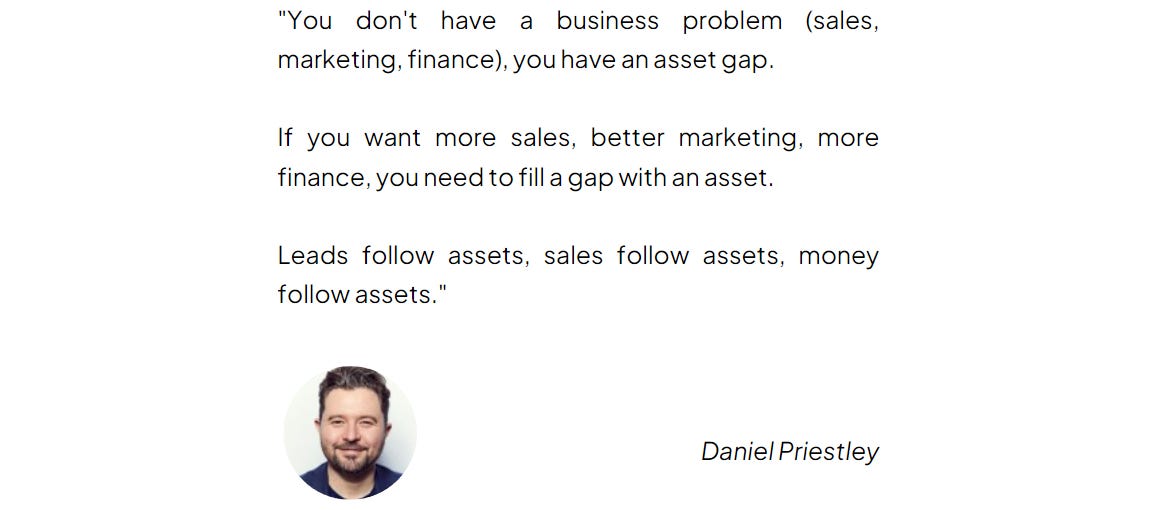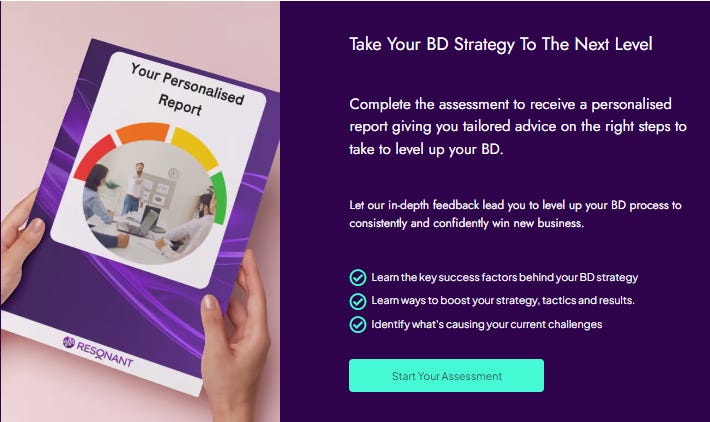Recruiters don't need BD training; it's a waste of time.
What they need is far rarer.
It all goes back to Daniel Priestley.
We can talk about the lack of skills, but what really hurts recruiters today, is a lack of assets supporting their BD efforts.
In this article I’ll break down the three types of sales assets every recruiter should have. And, in the bonus section, I’ll give you my the exact list of 30 assets you need to confidently and consistently win new business.
CORE ASSETS
These will include frameworks for developing clarity over your target audience, key messaging, process and performance.
Assets in this category help you understand who buys from you providing detailed insights that shape who you sell to next. They help you define your ICP and clarify where you get best returns on your time spent selling. Here you’ll track what your clients care about, how they experience the problem you solve and how it impacts them.
Rather than specific templates and frameworks, this is where you find the big ideas, key words and approaches that best engage your target clients. They might also include the specific problems you solve and ways of describing your solution
As you map out your sales process that map will be kept here. You should include a breakdown of the purpose and likely outcomes from each stage of your sales journey here too.
Finally, this is where you’ll build out your performance metrics, scorecards, and review tools.
Check out a recent episode of the Recruiting Better podcast where I discussed how to manage a key part of your sales process - the Discovery meeting.
OUTREACH ASSETS
This is where we find workflows, frameworks and templates and other tools that help consultants navigate turning leads into meetings.
Firstly, you’ll want a set of workflows clearly mapped out for every lead type you target. You’ll also want to get clarity over your nurture sequence for people who decline your outreach, or for whom the timing isn’t right.
Next you should ensure you have the frameworks, scripts and templates used for every piece of correspondence in your workflow. Some of these will be more fluid or agile than others. For example, a stock response to those who grab a lead magnet versus a referral follow-up. This should include voicenote and video scripts which are often overlooked by recruiters. Consistency breeds confidence - crucial for good outreach
Additional resources like disqualification criteria, objection handling cheat sheets and battle cards will also sit in this category].
CLOSING ASSETS
At last you need that present your solution, assets to help you multithread and frameworks for negotiating deals.
Your solution should be easy for clients to visualise. You consultants should also be able to give evidence and examples of how each element of your solution impacts your clients. More case studies and a few slides is usually the key action point here.
Very often the hiring manager is the first point of contact, so having assets that will quickly get HR and finance onside is key. Being able to present data and workflows that HR and Finance dig is a massive value add in your sales process. It also leads to better job intake and vacancy consultations and a higher instance of retained or fully committed clients.
It’s also amazing how few recruiters have a negotiation framework. Negotiation should form three parts - how you’ll collaborate (the level of service they’ll get), how they’ll commit (duration and scope of the agreement), cost (your fees). By having a clear framework for each category and a clear, yet flexible, product set you arm your consultants to land the maximum available value.
ACTION POINTS
As I recently mentioned on LinkedIn; the first thing to do is to review your list of documents and tools that support your BD approach and work out what you have, what needs work and where there are gaps.
In this week's deep dive, we're exploring 30 assets you need in your business.
Unlock the full article and audit your own process. 👇
Ben
P.S. Before you go, what's your take?
Share your thoughts in the comments - your perspective could spark someone else's eureka moment. And if these ideas strike a chord, why not loop in your colleagues?
Keep reading with a 7-day free trial
Subscribe to Recruiting Better to keep reading this post and get 7 days of free access to the full post archives.





